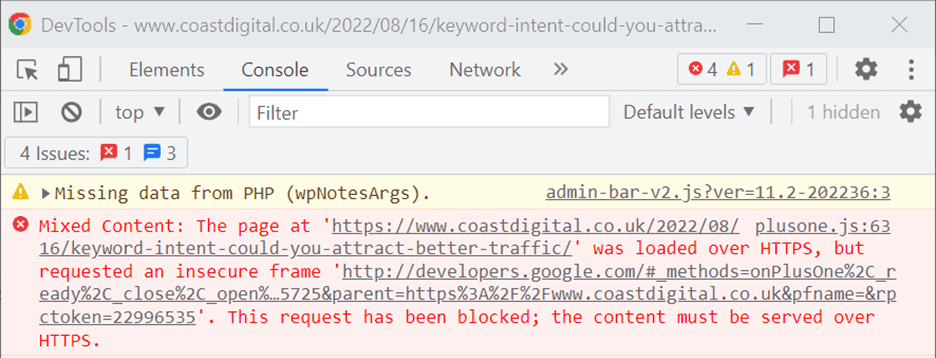Technical SEO can be a bit of a mystery. Even the most steely-eyed, SERP-hardened SEO occasionally flinches at the prospect of certain technical tasks, so it’s no wonder that the whole area is a minefield for the uninitiated.
Unfortunately, it’s also an area of SEO that you can’t afford to ignore. After all, what good is a website if it’s riddled with technical issues that affect how users interact with it? With that in mind, welcome to a new series of blog posts, in which we’ll cover an aspect of technical SEO, why you should fix it and how you fix it. Minimal technical knowledge, no jargon.
This brings us nicely to our first topic: Mixed content…
What is mixed content?
A few years ago, Google insisted that all websites should be served using SSL certificates, to ensure that user information entered on the site is encrypted and therefore minimise the risk of the information being stolen.
You may be familiar with websites being served under HTTPS, rather than HTTP, as a result. Mixed content is when the website is loaded over a secure HTTPS connection, but resources within the page are served under HTTP (usually images, videos, links etc).
Having resources loaded using HTTP weakens the security of the page, and leaves it open to “on-path attacks”, where an attacker can gain access to the site to replace or modify content, or take complete control of the page. A page that an attacker can hack represents a risk to users, so search engines prefer pages to be served completely securely.
How to identify mixed content
Our team of SEO specialists use tools to bulk-check websites for technical errors, but there is a way you can quickly check your most important landing pages manually. For the purposes of this article, we’ll be using Google Chrome.
The best bet is to prioritise your most important landing pages, so open them up in a browser and check the Omnibox (i.e. the address bar). If you see a notification that says “Insecure content found on the webpage”, you’ve probably got some mixed content.
Right click on the page and select “Inspect”, then navigate to the “Console” tab of the inspect pop-up. If there is any mixed content on the page, you should see a notification here.

How do you fix mixed content?
Depending on the type of content found, there are a number of ways to fix mixed content issues. In the case of links, all you need to do is edit the link to be https:// rather than http:// and you should be done. Images may need to be re-uploaded to the site and replaced to ensure that they’re served under your HTTPS policy, but in the case of embedded images (common in blog posts etc), you may be able to change the image source to https:// directly in the image link.
If you’re sharing a link to an external resource that is hosted by a third party and isn’t hosted under https://, it might be worth downloading a copy of the document, uploading it to your own site and sharing the link under your own HTTPS policy.
Need some help?
Fixing mixed content issues is pretty simple when you get the hang of it, but it can be incredibly time-consuming to explore manually. If you’re not overly confident with finding and fixing technical issues on your site or are worried about doing more harm than good, why not let our SEO team do the heavy lifting for you?
We routinely perform technical SEO audits for clients, and can work with your developers to make changes, or even make changes ourselves, so you can focus on what you do best. To speak to a member of our team about SEO support, get in touch with us today.
